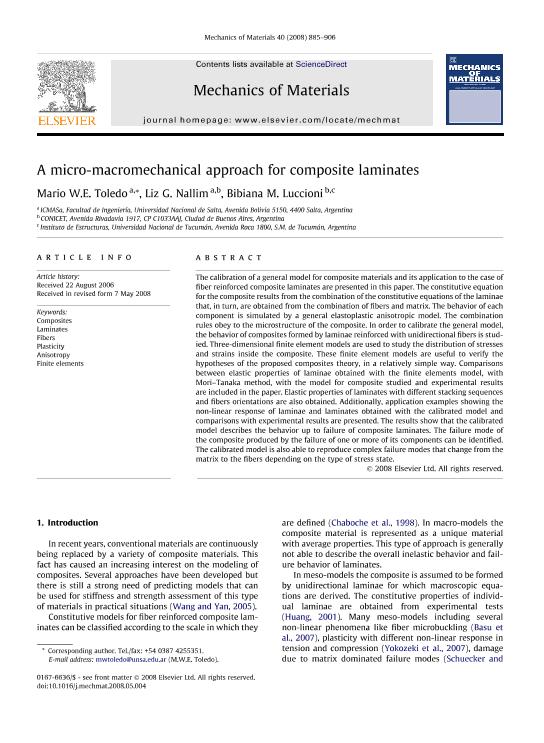Mostrar el registro sencillo del ítem
dc.contributor.author
Toledo, Mario Walter Efraín

dc.contributor.author
Nallim, Liz

dc.contributor.author
Luccioni, Bibiana Maria

dc.date.available
2018-10-03T19:10:06Z
dc.date.issued
2008-11
dc.identifier.citation
Toledo, Mario Walter Efraín; Nallim, Liz; Luccioni, Bibiana Maria; A micro-macromechanical approach for composite laminates; Elsevier Science; Mechanics of Materials; 40; 11; 11-2008; 885-906
dc.identifier.issn
0167-6636
dc.identifier.uri
http://hdl.handle.net/11336/61592
dc.description.abstract
The calibration of a general model for composite materials and its application to the case of fiber reinforced composite laminates are presented in this paper. The constitutive equation for the composite results from the combination of the constitutive equations of the laminae that, in turn, are obtained from the combination of fibers and matrix. The behavior of each component is simulated by a general elastoplastic anisotropic model. The combination rules obey to the microstructure of the composite. In order to calibrate the general model, the behavior of composites formed by laminae reinforced with unidirectional fibers is studied. Three-dimensional finite element models are used to study the distribution of stresses and strains inside the composite. These finite element models are useful to verify the hypotheses of the proposed composites theory, in a relatively simple way. Comparisons between elastic properties of laminae obtained with the finite elements model, with Mori-Tanaka method, with the model for composite studied and experimental results are included in the paper. Elastic properties of laminates with different stacking sequences and fibers orientations are also obtained. Additionally, application examples showing the non-linear response of laminae and laminates obtained with the calibrated model and comparisons with experimental results are presented. The results show that the calibrated model describes the behavior up to failure of composite laminates. The failure mode of the composite produced by the failure of one or more of its components can be identified. The calibrated model is also able to reproduce complex failure modes that change from the matrix to the fibers depending on the type of stress state. © 2008 Elsevier Ltd. All rights reserved.
dc.format
application/pdf
dc.language.iso
eng
dc.publisher
Elsevier Science

dc.rights
info:eu-repo/semantics/openAccess
dc.rights.uri
https://creativecommons.org/licenses/by-nc-sa/2.5/ar/
dc.subject
Anisotropy
dc.subject
Composites
dc.subject
Fibers
dc.subject
Finite Elements
dc.subject
Laminates
dc.subject
Plasticity
dc.subject.classification
Ingeniería de los Materiales

dc.subject.classification
Ingeniería de los Materiales

dc.subject.classification
INGENIERÍAS Y TECNOLOGÍAS

dc.title
A micro-macromechanical approach for composite laminates
dc.type
info:eu-repo/semantics/article
dc.type
info:ar-repo/semantics/artículo
dc.type
info:eu-repo/semantics/publishedVersion
dc.date.updated
2018-09-27T15:47:55Z
dc.journal.volume
40
dc.journal.number
11
dc.journal.pagination
885-906
dc.journal.pais
Países Bajos

dc.journal.ciudad
Amsterdam
dc.description.fil
Fil: Toledo, Mario Walter Efraín. Consejo Nacional de Investigaciones Científicas y Técnicas; Argentina. Universidad Nacional de Salta. Facultad de Ingenieria; Argentina
dc.description.fil
Fil: Nallim, Liz. Consejo Nacional de Investigaciones Científicas y Técnicas; Argentina. Universidad Nacional de Salta. Facultad de Ingenieria; Argentina
dc.description.fil
Fil: Luccioni, Bibiana Maria. Consejo Nacional de Investigaciones Científicas y Técnicas; Argentina. Universidad Nacional de Tucumán; Argentina
dc.journal.title
Mechanics of Materials
dc.relation.alternativeid
info:eu-repo/semantics/altIdentifier/doi/https://dx.doi.org/10.1016/j.mechmat.2008.05.004
dc.relation.alternativeid
info:eu-repo/semantics/altIdentifier/url/https://www.sciencedirect.com/science/article/pii/S0167663608000653
Archivos asociados
